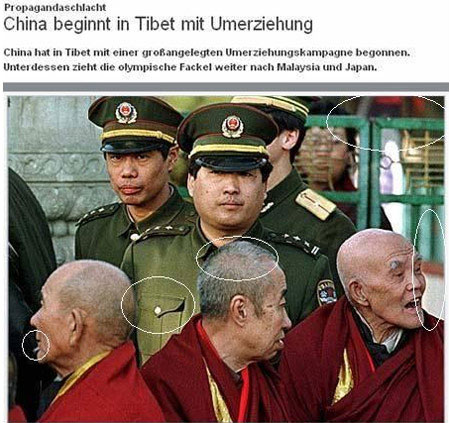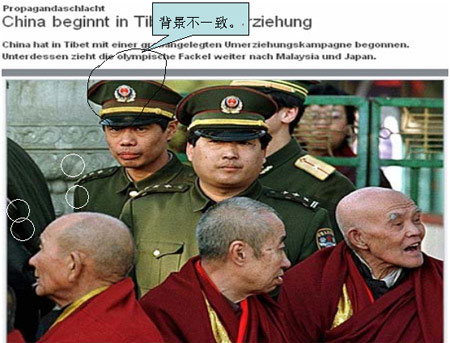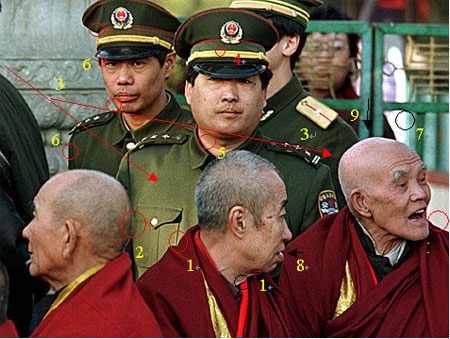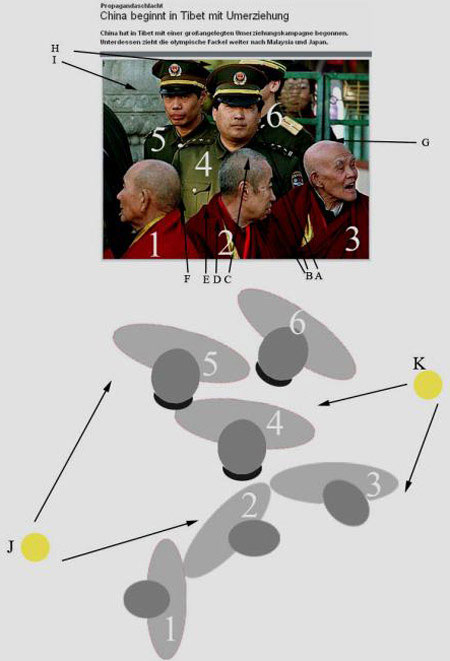German N24 TV publishes merged photo on its website
(Xinhua)
Updated: 2008-05-27 16:06
Updated: 2008-05-27 16:06
BEIJING -- In the latter part of April, the German N24 TV channel published on its website a piece of news titled "Propaganda Battle - China Begins to Ideologically Remold Tibet". A photo depicting Chinese police and lamas together was embedded in the news story with a caption stating: "Chinese policemen are watching Tibetan lamas conducting rituals in Beijing". The Associated Press was identified as the source of the photo.
Some specialists said that the photo was a composite merged by two or more photos taken long before.
Analysis one
 |
2. The sunlight on the uniform of the policeman (middle) can't be discerned on the old man in the front, demonstrating that the color spectrum in one photo doesn't match.
3. The edge of the head of lama (left) has overlapped with the policeman (middle). It is blurred and a white outline can be discerned on the head of the lama (right) if the picture is magnified several times. This is proof that the images of the lamas were cut and pasted with other images in the photo.
4. There is a white strip under the mouth of the lama (left) that is either a strip stitched onto the police uniform or a trace of photo combination. To make sure, others have suggested checking whether there is such a strip on the police uniform and its position.
5. The window on the picture is also suspicious. There is no wall on the top of the window and the frame below is so blurred - both of which are conspicuous traces left by Photoshop.
Analysis two
|
|
1. The stone wall and the iron window frame in the background are obviously inconsistent with each other.
2. The lighting reflecting different figures is not consistent. The policeman in the middle is illuminated by natural light while flash lighting might have been used on the lama in the front. Additionally, having compared the colors of the lamas' robes, it seems that the lama on the left and the other two on the right were photographed with different cameras.
3. The police uniforms in the picture are out-of-date; newer style uniforms replaced them in 2000.
4. Circles in the picture indicate traces left by Photoshop.
Analysis three
|
|
2. The middle top of the lama's (left) head is blurred and the edge line varies in width.
3. The shadows on the policeman in the middle and behind him were not made by identical light sources. (The red line indicates the light direction.)
4. The yellow strip on the hat of the policeman (middle) is a pixel-level straight line.
5. There is a bright strip on the neck of the policeman (middle) and a pixel-level straight line can be seen to the left of his neck.
6. Regarding the policeman on the left, conspicuous edge lines can be seen on his hat, face, shoulders and arm, and there is a pixel-level straight line on his right arm.
7. There is an excessively bright bar (totally white) in the rear of the window that does not conform to the light intensity. There is a pixel-level straight border line to the right of the bar but the border linking its middle part and the green window frame is curved.
8. The bright point on the lip of the lama (middle) does not conform to established light rules.
9. The head of the lama (right) was illuminated by light that is inconsistent with the light on the policemen.
10. The stone wall, the iron frames and the house in the rear reflect a confusing space relationship.
Other questionable points
|
|
Firstly, according to all pertinent analyses, figures 1, 2, 3 are in sitting postures and figures 4, 5, 6 are in standing posture.
Suppose each of the six figures is 175 cm tall, a general male height. If the lamas were sitting on the ground, the head of the figure 2 should be at the front of the navel section of figure 4. But as the photo shows, figure 2's head tops the neck of figure 4, from which the height of figure 2 could be deduced at over 2 meters. And figure 3 should be at least 2.1 meters in tall as his head surpassed the shoulder of figure 4 (indicated by mark G).
Secondly, suppose figure 1, 2, 3 were sitting on chairs. Then the head of figure 2 should be in front of the coat pockets of figure 4, but what's shown on the picture is inconsistent with the rules of perspective. Thus, the images in the photo are suspicious and have probably been altered.
Thirdly, according to the figure arrangement of the photo, those in the front should occupy more space than in the rear part. But as the photo shows, the lamas in the front occupy a comparative smaller part than the policemen.
Light sources
Figures 2 and 3 show light shining from the rear right area (indicated by mark K). That explains the highlighting on figure 2's lower lip and the outline light on his forehead (indicated by B), and also the outline light on the top and back of figure 3's head. Under the light from a same light source (K), the left part of figure 4's face and his left shoulder should be as bright as figure 2, but what is shown on the photo is just to the contrary. The faces of figures 4, 5, 6 indicate light from the front left (J), proven by the bright area on the right chest of figure 4.
Taking the premise that the photo was taken outdoors under natural light, if the light source J is supposed to be sunlight, then K is not tenable as it's impossible to make an artificial sunlight source with a color temperature of around 5,400 k.
Furthermore, it's impossible for a photo taken under natural light to have two sunlight sources located in opposite positions, thus the photo can be deemed a composite.
Traces left by Photoshop
Firstly, figure 4's left collar is evidently overlaid with figure 2's head as mark C indicates. Using the Photoshop tool rubber stamp or putting the tool in the status of feathered semi-transparence, which the person who merged photos used when cutting out figure 2, figure 4's collar appears to be semi-transparently overlaid after it was merged with figure 2.
Secondly, the red robe on the back of figure 2's right shoulder lies in a straight-line (indicated by E). Even if the image is zoomed in 800 percent, it remains non-mosaic, because the person when cutting out the images to merge used the straight-line tool. But there is evident difference in the mosaic size in the part (see D) with 800 percent zoom-in and its surrounding areas. Four pieces of mosaic (see D), having covered the folding shadow in the original picture, are greatly enlarged than the mosaics in its surrounding areas.
Thirdly, the overlapped part of the back of the head of figure 1 with the right coat pocket and stitched line of right sleeve of figure 4 is very blurred. Since human skin and hair belong to a kind of texture totally different from that of the materials the police uniform was made of, and furthermore, the focus of the figure 1's head and figure 4 are both within an established depth of field, this overlapped part should not be that blurred (indicated by F).
Fourthly, the depth of focus at the area pointed by H is apparently different from the area pointed by I. The pattern on the wall pointed by I is clear while the H area is so blurred that its texture is hard to tell, and the iron frame and the figure behind are comparatively clear. It is unreasonable to have parts with different depths of focus in a single plane.
Conclusion: To sum up, the photo published by N24 website is pieced together by two or more pictures.
Currently, the photo and the report cannot be found at the N24 website, but can be found via Google.
Such acts of falsifying photos and news to deceive readers should be condemned.
|
||
|
||
|
|
|
|


